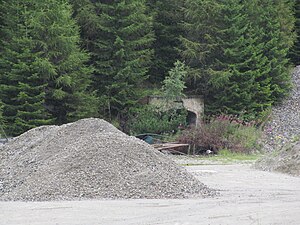Bedretto window
| Bedretto window | ||
|---|---|---|
|
View of the tunnel entrance from the Nufenen pass road
|
||
| use | Railway tunnel for construction railway | |
| length | 5221 m | |
| Number of tubes | 1 | |
| business | ||
| release | 1973 | |
| closure | 1982 | |
| location | ||
|
|
||
| Coordinates | ||
| Bedretto window | 681114 / 150153 | |
| West portal | 670700 / 154243 | |
| East portal | 681437 / 160813 | |
The Bedretto window is the name of the Furka Base Tunnel , which connects the middle of the tunnel under the Saashorns with the lower part of the Bedretto Valley and ends in Ronco near Airolo .
The tunnel was originally planned to be 6100 m long and, thanks to the southern bulge of the Furka Base Tunnel, was ultimately 5221 m long. It has a cross-section of 9 to 10 square meters.
During construction it was used by a tunnel railway with a gauge of 600 mm.
history
As early as 1955, an initiative committee "for a tunnel railway Oberhasli - Goms - Bedrettotal " submitted a license application for two tunnels that were to connect the cantons of Bern , Valais and Ticino . Specifically, a tunnel connection from Oberwald to Ronco was planned. The application was revised until 1957.
In 1960 the project, based on the “ Syndicat d'initiative pour le tunnel Oberwald- Realp ”, was competed by the Furka base tunnel.
In 1965 a study by Motor-Columbus on the Furka Base Tunnel came to the conclusion that a shaft in the middle of the tunnel would not bring about any savings.
In 1968 it was also analyzed whether a direct tunnel connection from Ulrichen to Val Bedretto would be useful. In the study, the idea of a tunnel Y between the cantons of Valais, Uri and Ticino appeared for the first time .
In May 1970, the Federal Military Department criticized the Bedretto window and described it as "militarily undesirable", without however using a veto.
In June 1970 the project, including the Bedretto window, was approved by the Federal Council, with the prospect of cost savings of 2 million francs thanks to the Bedretto window. This potential cost saving was not based on a publicly available calculation and was in contradiction to the study by Motor-Columbus. However, it was also supported by the Council of States commission in October 1970, but the Société générale pour l'industrie (SGI) came to the conclusion that the Bedretto window would probably - on the contrary - cause additional costs of the same size. In February 1971, National Councilor Robert Eibel also established a connection between the Bedretto window and the southern bulge of the route of the main tunnel, but was not approved.
In June 1971 it was decided to build the main tunnel and Bedretto window, but the Bedretto window was repeatedly called into question until construction began in June 1973. The tunnel has been closed since the Furka Base Tunnel was opened in 1982.
Reasons to build
The following reasons were given by various interest groups as motivation for the construction:
- Technical advantages in construction.
- Risk reduction in case of geological difficulties.
- Increase the construction speed by one to two years.
- Expansion options.
However, the presumed advantages could largely not be realized. In particular, despite the Bedretto window, the work in the main tunnel could not be carried out in full profile because the ventilation through the tunnel was too weak. In particular, no time savings could be realized.
Although the military department criticized the Bedretto window in the planning phase, the popular opinion still exists today that the Bedretto window was built for military reasons, among other things.
present
Even if it was initially planned to concretize the tunnel at the portal in Ronco, it has only been closed by an iron gate to this day. A possible use of the Bedretto window is still being discussed today, as for example a study commissioned by the Canton of Graubünden in August 2005 or a similar study by the municipalities of Alta Leventina from 2006 testify.
The use of the Bedretto window on the occasion of Sion's candidacy for the Olympic Games in 2006 was also discussed.
The entrance, which is in the back of the gravel works at the junction of the Nufenen pass road and the road to Ronco (southwest of the village), is overgrown with bushes.
From 2018, the tunnel was expanded into a laboratory in which ETH Zurich will conduct research on geothermal energy. On May 18, 2019 the "Bedretto Underground Laboratory for Geoenergies" was officially opened. This is located roughly in the middle of the tunnel in a niche that was originally intended as a crossing point for the trains. For the realization of the rock laboratory, the tunnel had to be cleared of debris in some places and newly secured.
Web links
- Report of the Commission of the National Council on its clarification of any incorrect dispositions of April 13, 1978
- Construction site south portal 1980 and 1975
- Bedretto Laboratory at ETH Zurich (English and Italian)
- History of the Bedretto Laboratory at ETH Zurich
Individual evidence
- ^ Hermann Alb: Gotthard spatial concept - basics, content, structure and process (PDF; 1.9 MB) raonline.ch. August 31, 2005. Retrieved August 11, 2011.
- ↑ MGF CONSULENZE SA (2006). Studio di scenari aggregativi in Alta Leventina.
- ↑ SCCER-SoE | Bedretto BULG. Retrieved May 15, 2019 .
- ↑ http://www.bedrettolab.ethz.ch/about/history/


